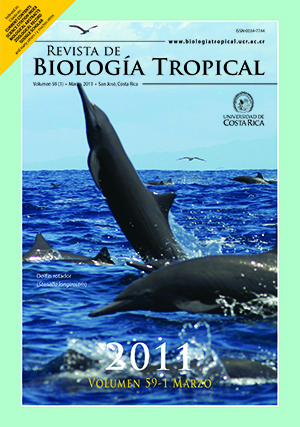Abstract
Astropecten marginatus is a sea star widely distributed in Northern and Eastern South America, found on sandy and muddy bottoms, in shallow and deep waters. To describe some of its ecological characteristics, we calculated it spatial-temporal distribution, population parameters (based on size and weight) and diet in the Orinoco Delta ecoregion (Venezuela). The ecoregion was divided in three sections: Golfo de Paria, Boca de Serpiente and Plataforma Deltana. Samples for the rainy and dry seasons came from megabenthos surveys of the “Línea Base Ambiental Plataforma Deltana (LBAPD)” and “Corocoro Fase I (CFI)” projects. The collected sea stars were measured, weighted and dissected by the oral side to extract their stomach and identify the preys consumed. A total of 570 sea stars were collected in LBAPD project and 306 in CFI one. The highest densities were found during the dry season in almost all sec-tions. In LBAPD project the highest density was in “Plataforma Deltana” section (0.007±0.022ind/m2 in dry season and 0.014±0.06ind/m2 in rainy season) and in the CFI project the densities in “Golfo de Paria” section were 0.705±0.829ind/m2 in rainy season and 1.027±1.107ind/m2 in dry season. The most frequent size range was 3.1-4.6cm. The highest biomass was found in “Golfo de Paria” section (7.581±0.018mg/m2 in dry sea-son and 0.005±6.542x10-06mg/m2 in rainy season for 2004-2005 and 3.979±4.024mg/m2 in dry season; and 3.117±3.137mg/m2 in rainy season for 2006). A linear relationship was found between the sea star size and its weight but no relationship was observed between its size and the depth where it was collected. Mollusks are dominant in the sea star diet (47.4% in abundance). The diet in any of the sections, seasons or between projects or size class was heterogeneous, using multivariate ordinations (MDS) and SIMPER analysis and there was no difference in the prey number or food elements that a sea star can eat. Although A. marginatus has been described as a predator, in this study were also inferred scavenger and detritivorous habits.
##plugins.facebook.comentarios##

This work is licensed under a Creative Commons Attribution 4.0 International License.
Copyright (c) 2011 Revista de Biología Tropical


